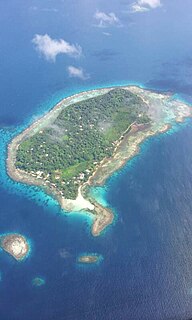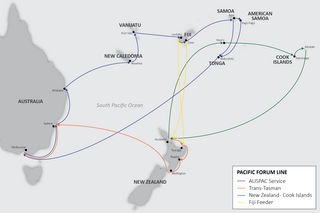
Micronesia is a subregion of Oceania, composed of thousands of small islands in the western Pacific Ocean. It has a shared cultural history with two other island regions: Polynesia to the east and Melanesia to the south.

The history of human activity in Nauru, an island country in the Pacific Ocean, began roughly 3,000 years ago when 12 Micronesian and Polynesian clans settled the island.

The demographics of Nauru, an island country in the Pacific Ocean, are known through national censuses, which have been analysed by various statistical bureaus since the 1920s. The Nauru Bureau of Statistics have conducted this task since 1977—the first census since Nauru gained independence in 1968. The most recent census of Nauru was in 2011, when population had reached ten thousand. The population density is 478 inhabitants per square kilometre, and the overall life expectancy is 59.7 years. The population rose steadily from the 1960s until 2006 when the Government of Nauru repatriated thousands of Tuvaluan and I-Kiribati workers from the country. Since 1992, Nauru's birth rate has exceeded its death rate; the natural growth rate is positive. In terms of age structure, the population is dominated by the 15–64-year-old segment (65.6%). The median age of the population is 21.5, and the estimated gender ratio of the population is 0.91 males per one female.

Nauru, following independence from the United Kingdom, became a sovereign, independent republic on 31 January 1968. Nauru has established diplomatic relations with a number of nations, including most of its Pacific neighbors with which it maintains economic, cultural and administrative ties with its regionally.

The Pacific Rim comprises the lands around the rim of the Pacific Ocean. The Pacific Basin includes the Pacific Rim and the islands in the Pacific Ocean. The Pacific Rim roughly overlaps with the geologic Pacific Ring of Fire.

The Pacific Islands Forum (PIF) is an inter-governmental organization that aims to enhance cooperation between countries and territories of the Pacific Ocean. It was founded in 1971 as the South Pacific Forum (SPF). In 1999, the name was changed; "Pacific Islands Forum" is more inclusive of the Forum's Oceania-spanning membership of both north and south Pacific island countries, including Australia. It is an observer at the United Nations.

Denigomodu is a district in the western part of the island of Nauru. It is the most populous settlement in Nauru.
Checkbook diplomacy, or chequebook diplomacy, is used to describe a foreign policy which openly uses economic aid and investment between countries to curry diplomatic favor.
Nauru is a small island country in the South Pacific. With a population of 9,322 it is the world's least populous independent republic. Nauru's government operates under its constitution, part two of which contains 'protection of fundamental rights and freedoms.' The Human Rights Council (UNHRC) carried out Nauru's Universal Periodic Review (UPR) in January 2011. The review was generally favourable with only a few areas of concern.
The Pacific Agreement on Closer Economic Relations (PACER) is an umbrella agreement between members of the Pacific Islands Forum which provides a framework for the future development of trade cooperation.

The following outline is provided as an overview of and topical guide to Nauru:

The German attacks on Nauru refers to the two attacks on Nauru in December 1940. Nauru is an island country in Micronesia, a subregion of Oceania, in the Central Pacific. These attacks were conducted by auxiliary cruisers between 6 and 8 December and on 27 December. The raiders sank five Allied merchant ships and inflicted serious damage on Nauru's economically important phosphate-loading facilities. Despite the significance of the island to the Australian and New Zealand economies, Nauru was not defended and the German force did not suffer any losses.

Education in Nauru is compulsory for children between the ages of 5 and 16. There are eleven schools in Nauru, including three primary schools and two secondary schools. There is an Able/Disable Centre for children with special needs. Education at these schools is free. In 2011, the Australian Department of Foreign Affairs and Trade reported that 3,026 children were enrolled at Nauru's schools. The Minister for Education is the Hon. Charmaine Scotty, MP from 2013.

India-Nauru relations refers to the international relations that exist between India and Nauru. These have been established since the island's independence in 1968.

Nauru–Philippines relations are the bilateral relations between Nauru and Philippines. The Philippines maintains relations with Nauru through its embassy in Canberra, Australia

Nauru Secondary School (NSS) is an upper secondary school in Yaren District, Nauru, located in the Nauru Learning Village, along with the University of the South Pacific Nauru Campus and the Nauru Technical & Vocational Education Training Centre. It serves years 10-12 and has the final stages of secondary education in Nauru. As of 2002 it served years 8 through 12. It uses the curriculum of Queensland, Australia.
















